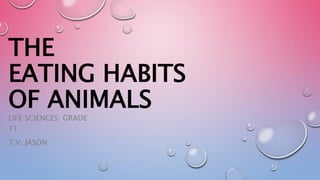
Animal nutrition.pptx
- 1. THE EATING HABITS OF ANIMALS LIFE SCIENCES: GRADE 11 T.V. JASON
- 2. REMEMBER !! SOME FOOD COMES FROM PLANTS. PLANTS ARE A TYPE OF AUTOTROPHS THAT CAN PRODUCE THEIR OWN FOOD THROUGH THE PROCESS OF (Bu, 2013; Mabope, 2022)
- 3. SOME FOOD COMES FROM ANIMALS (Bu, 2013)
- 4. All animals need to eat food to give them nutrients that they will use everyday. Teeth are a vital component of physically breaking down food into smaller soluble molecules.
- 6. THE LOCATION AND FUNCTION OF THE TYPES OF TEETH • INCISORS Front, chiseling or nipping tooth. • CANINES On either side of incisors and it is useful in biting and piercing prey • PREMOLARS It is also known as “cheek teeth” and they do some grinding and mashing (Zahid, 2013) • MOLARS Back teeth that do most of the grinding and chewing
- 7. Mammalian animals have teeth that are adapted to eating certain types of food. Although there are four types of teeth, not every mammal has all of them. The types of teeth they have are depended on their diet.
- 8. DIFFERENT DIETS FOR MAMMALIAN SPECIES Herbivores Omnivor es Carnivore s
- 9. HERBIVORES • “Herbi” = plant and “vore”= eater. • Therefore, these animals consume plant material. • Leaves, fruits, roots and even the bark of trees are plants that herbivores may eat. • They often need to eat a lot during the day inorder to have enough energy () • Some herbivores include: Zebras, rabbits and giraffes.
- 11. Herbivores’ teeth adaptations based on their diet: • Use incisors to cut the plant material • Usually lack canines • Use molars and premolars to grind food
- 12. CARNIVORES • “Carni” = meat and “vore”= eater. • Therefore, these animals are meat eaters and obtain food by hunting and killing their prey. • These animals are rather large. • Some of the animals that follow this diet eat insects and bugs ,while others eat animals such as fish or rat which are a considered small animals. Then we get carnivores which eat bigger animals such as buffalos or wolves (Estape, 2014 ) • Example of carnivores include: Lions, foxes and African wild dogs
- 14. Carnivores’ teeth adaptations based on their diet: • Use incisors to slice or shred meat. • Large and well developed canines used for catching, holding and tearing meat • Molars and premolars are modified to form Carnassial teeth. According to Meckelb (2007) carnassial teeth are 4th upper premolars and 1st lower molars that is specialized for meat shearing.
- 15. OMNIVORES • “Omni” = All and “vore”= eater. • Therefore, these animals are adapted to eating both plant and animal tissue. • Omnivores are able to obtain food faster. Why ? • This is because omnivores have a variety of food to choose from compared to herbivores and carnivores. • Some omnivores include: Hens, pigs and even people.
- 17. Omnivores’ teeth adaptations based on their diet: • They have all four types of teeth that are well developed. • Their teeth are modified for eating both plant material and meat similar to those in humans
- 19. REFERENCES Bu, K. (2013) Carnivores herbivores omnivores_KAH. Available from Slideshare at : https://www.Slideshare.net/Kay-Bu/carnivores-herbivores-omnivoreskah?qid=28462457-042f-45d7-a46a- ab0f9c7ec87&v=&b=&from-search=1 .(Accessed: 20 August 2022) Estape, V. (2014) .Available from Slideshare at : https://www.Slideshare.net/veronicaestape/the- eatinghabitsofanimalspptteeth?qid=47062a58-60aa41a3-bfa7-d8846bad25a&v=&b=from_search=5. (Accessed: 19 August 2022) Mabope, A. (2022) Heterotrophs and Autotrophs. Available from Slideshare at: https://www.Slideshare.net/AmahleMabope/heterotrophs-and-autotrophspptx. (Accessed: 20 August 2022) Meckelb, T. (2007) Companion Animal Dentistry Kk. Available from Slideshare at : https://ww.Slideshare.net/meckelbt/companion-animal-dentistry-kk?qid=69998bca-e893-4ee8-b470- 0599d6dd78fb&v=&b=&from-search=1 .(Accessed: 18 August 2022) Zahid, O. (2013) Anatomy lecture: Digestive System (1st Semester). Available from Slideshare at : https://www.slideshare.net/PakRose1/lecture-9-digestive-system?qid=b6f3c680-0cdc-440b-a41a- 579dc321a522&v=&from_search=7 . (Accessed: 20 August 2022)
